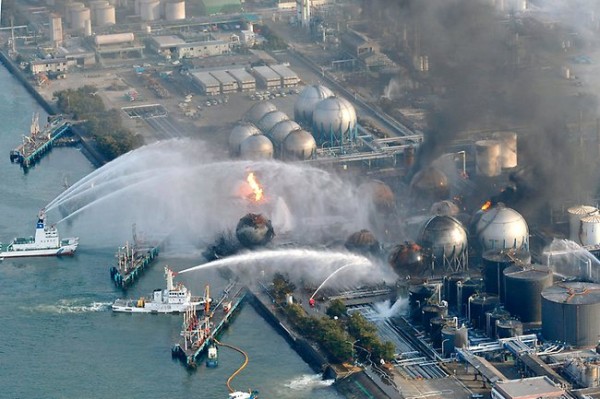It is highly possible that a partial meltdown was occurring in one of the nuclear reactors damaged in Friday’s powerful earthquake and by Sunday afternoon, the death toll from the country’s strongest-ever earthquake in more than a century and the crushing walls of water that followed had risen to 801.For this tsunami and earthquake up to 10,000 feared dead in Miyagi prefecture alone, cooling tem fails at a second nuclear plant,number of rescuers doubled to 100,000,190 people exposed to radiation,as a result millions without power and drinking water……..
An 8.9 magnitude earthquake off the coast of Northeast Japan spawned a ferocious tsunami that’s caused massive destruction; flattening whole cities, starting raging fires and killing hundreds. Nearly 88,000 people are reported missing, according to the official Kyodo news agency.The death toll in Japan’s earthquake and tsunami will likely exceed 10,000 in one state alone, an official said Sunday, as millions of survivors were left without drinking water, electricity and proper food along the pulverized northeastern coast.Although the government doubled the number of soldiers deployed in the aid effort to 100,000, it seemed overwhelmed by what’s turning out to be a triple disaster: Friday’s quake and tsunami damaged two nuclear reactors at a power plant on the coast, and at least one of them appeared to be going through a partial meltdown, raising fears of a radiation leak.
The police chief of Miyagi prefecture, or state, told a gathering of disaster relief officials that his estimate for deaths was more than 10,000, police spokesman Go Sugawara told The Associated Press. Miyagi has a population of 2.3 million and is one of the three prefectures hardest hit in Friday’s disaster. Only 379 people have officially been confirmed as dead in Miyagi.The nuclear crisis posed fresh concerns for those who survived the earthquake and tsunami, which hit with breathtaking force and speed, breaking or sweeping away everything in its path.The U.S. Geological Survey calculated the initial quake to have a magnitude of 8.9, while Japanese officials raised their estimate on Sunday to 9.0. Either way it was the strongest quake ever recorded in Japan. It has been followed by more than 150 powerful aftershocks.eams searched for the missing along hundreds of miles (kilometers) of Japanese coastline and hundreds of thousands of hungry survivors huddled in darkened emergency centers that were cut off from rescuers and aid. At least 1.4 million households had gone without water since the quake struck and some 2.5 million households were without electricity. Temperatures were to dip near freezing overnight.
Trade Minister Banri Kaeda said the region was likely to face further blackouts and that power would be rationed to ensure supplies go to essential needs.Large areas of the countryside remained surrounded by water and unreachable. Fuel stations were closed and people were running out of gasoline for their vehicles.Public broadcaster NHK said around 380,000 people have been evacuated to emergency shelters, many of them without power.In Iwaki town, residents were leaving due to concerns over dwindling food and fuel supplies. The town had no electricity and all stores were closed. Local police took in about 90 people and gave them blankets and rice balls but there was no sign of government or military aid trucks.At a large refinery on the outskirts of the hard-hit port city of Sendai, 100-foot (30-meter) -high bright orange flames rose in the air, spitting out dark plumes of smoke. The facility has been burning since Friday. A reporter who approached the area could hear the roaring fire from afar, and after a few minutes the gaseous stench began burning the eyes and throat.
At a small park near the refinery, trees and large swaths of grass were covered in thick black crude oil. Two large tanker trucks were jammed sideways among the trees, their gas tanks crumpled.Residents said the water surged in and quickly rose higher than the first floor of buildings. At Sengen General Hospital the staff worked feverishly to haul bedridden patients up the stairs one at a time. With the halls now dark, those that can leave have gone to the local community center.One older neighborhood sits on low ground near a canal. The tsunami came in from the canal side and blasted through the frail wooden houses, coating the interiors with a thick layer of mud and spilling their contents out into the street on the other side.Dozens of countries have offered assistance. Two U.S. aircraft carrier groups were off Japan’s coast and ready to provide assistance. Helicopters were flying from one of the carriers, the USS Ronald Reagan, delivering food and water in Miyagi.
A partial meltdown was already likely under way at one nuclear reactor, a top official said, and operators were frantically trying to keep temperatures down at the power plant’s other units and prevent the disaster from growing even worse.Chief Cabinet Secretary Yukio Edano said “Sunday that a hydrogen explosion could occur at Unit 3 of the Fukushima Dai-ichi nuclear complex, the reactor that could be melting down. That would follow a blast the day before in the power plant’s Unit 1, as operators attempted to prevent a meltdown by injecting sea water into it.however, there would be no significant impact on human health.” More than 170,000 people had been evacuated as a precaution, though Edano said the radioactivity released into the environment so far was so small it didn’t pose any health threats.
Up to 160 people, including 60 elderly patients and medical staff who had been waiting for evacuation in the nearby town of Futabe, and 100 others evacuating by bus, might have been exposed to radiation, said Ryo Miyake, a spokesman from Japan’s nuclear agency. The severity of their exposure, or if it had reached dangerous levels, was not clear. They were being taken to hospitals.Japan struggled with the nuclear crisis as it tried to determine the scale of the Friday disasters, when an 8.9-magnitude earthquake, the most powerful in the country’s recorded history, was followed by a tsunami that savaged its northeastern coast with breathtaking speed and power.Rescue teams were struggling to search hundreds of miles (kilometers) of devastated coastline, and thousands of hungry survivors huddled in darkened emergency centers cut off from rescuers and aid. At least a million households had gone without water since the quake, and food and gasoline were quickly running out across the region. Large areas of the countryside were surrounded by water and unreachable. Some 2.5 million households were without electricity.
Officials were aware that the steam contained hydrogen and were risking an explosion by venting it, acknowledged Shinji Kinjo, spokesman for the government’s Nuclear and Industrial Safety Agency, but chose to do so because they needed to keep circulating cool water on the fuel rods to prevent a meltdown.To cool the reactor fuel, operators needed to keep circulating more and more cool water on the fuel rods. But the temperature in the reactor vessel apparently kept rising, heating the zirconium cladding that makes up the fuel rod casings.If the temperature inside the Fukushima reactor vessel rose further, to roughly 4,000 degrees Fahrenheit (2,200 Celsius), then the uranium fuel pellets would start to melt. But once the zirconium reached 2,200 degrees Fahrenheit (1,200 Celsius), it reacted with the water, becoming zirconium oxide and hydrogen.When the hydrogen-filled steam was vented from the reactor vessel, the hydrogen reacted with oxygen, either in the air or water outside the vessel, and exploded.According to experts interviewed by The Associated Press, any melted fuel would eat through the bottom of the reactor vessel. Next, it would eat through the floor of the already-damaged containment building. At that point, the uranium and dangerous byproducts would start escaping into the environment.
Videos:
Sources :yahoo.com,(2),(3)
Click On Ads To Buy Android Devices




